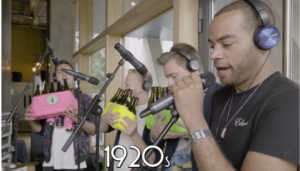Independent research conducted with 8,000 consumers reveals that Europeans are more worried about health and food safety than environmental problems, international terrorism or public safety; the role of packaging in food safety is amongst a list of key concerns.
The findings unveil a growing concern amongst European consumers linked to the potential health risks of chemical compounds leaching into food from packaging. Two thirds (66%) of consumers admit that they are worried about food contamination, as well as the risk of chemicals leaching from food packaging into its content.
Eight out of ten consumers surveyed believe these chemical interactions could be a risk to human health. The findings also reveal that European consumers (60%) are most worried about plastic containers impacting the food/beverage content or ingredients out of all materials surveyed including metal, cartons, bag in box, plastics and glass.
Health concerns play a key role in consumer decision making, and in driving demand for food or beverages packed in glass. Among those who opt for glass, 61% trust it as the safest packaging for their health. This compares with 48% of consumers surveyed in 2010.
Commenting on behalf of the Friends of Glass Community, Adeline Farrelly – Secretary General of FEVE, the European Container Glass Federation states: “It is clear that consumers worry about contamination from packaging. Nowadays, consumers are looking at how products are stored and packaged – not only at what’s written on the label. Studies show packaging materials are leaking chemicals into food; which is a very real concern. Parents of young children are particularly cautious: 77% of European parents prefer glass for storing baby food, while 61% avoid buying baby food in plastic bottles or other materials.”
Commenting on the existing body of scientific research that has examined migration of chemicals from packaging materials, Professor Dieter Schrenk, an expert in Pharmacology and Toxicology at the University of Kaiserslautern, Germany states: “The issue of transfer of food packaging material-borne compounds into the food is important. Here, plastic polymers, metals and paper/cardboard have been shown in the past to be a relevant source for unwanted chemicals in food. These occur via migration of mostly intentionally added or process-related constituents. Although the risk of exposure towards food contaminated with such compounds is considered as low, more research is needed to clarify this issue scientifically.”
Adeline Farrelly continued: “To avoid unwanted contamination from packaging, particularly when making important decisions such as during the weekly family shop, consumers should ‘look beyond the label’ – not only at a product’s ingredients but also at what form of packaging they are buying. An increasing number of Europeans surveyed (87% compared to 74% of those surveyed in 2010) recommend glass as their number one packaging choice for food or beverages. This clearly demonstrates consumers trust glass as one of the most pure and inert materials”.
Glass is the packaging material which acts as a natural and impermeable barrier; it does not interact with food and drink products. In the US, glass is the only widely-used packaging material considered “GRAS” or “generally recognized as safe” by the U.S. Food and Drug Administration[1]. In 2011, when banning the use of BPA[2] for plastic baby bottles, the EU recommended glass[3] as a safe alternative for human health.
The EU Commission is strengthening legislation related to chemicals which leach out of food packaging. Glass packaging will meet the most stringent of any future EU food contact standards and regulations because glass is chemically inert, meaning that it does not interact with its contents and it is impermeable to external contaminants.
Visit our Media Library for more videos and images
USEFUL DOCUMENTS
17 May 2014 (pdf)
Editor’s Notes:
About the survey:
In February 2014, the independent research agency, InSites Consulting, conducted a consumer survey in 11 European countries (France, Italy, Germany, Spain, the UK, Austria, Croatia, Czech Republic, Poland, Slovakia and Switzerland). Commissioned by FEVE, as part of the Friends of Glass campaign, over 8,000 consumers between the ages of 24 and 64 years were surveyed about their perception of food packaging related to food safety, environment and taste. 41% of the participants were parents; 75% were women, 25% were men. The results are representative for each country.
About Friends of Glass:
Friends of Glass is an influential European consumer forum that supports and promotes the right of consumers to be able to choose food and drink products in glass packaging. It unites all those who believe glass is the clear choice for their health, their families and for the environment. Friends of Glass was initiated in 2009 by the European Container Glass Federation (or FEVE) in response to a pan-European survey commissioned by FEVE in September 2008 by the research institute InSites, which found that 74% of European consumers prefer glass packaging for their food and drinks. Today this figure has increased to 87%.
About FEVE:
FEVE (The European Container Glass Federation) is the association of European manufacturers of glass packaging containers and machine-made glass tableware. The federation represents the glass container industry at the international, and especially European, level and serves as a forum for examining common questions. FEVE maintains a dialogue with the European institutions and agencies on environmental, trade and other important issues. The federation promotes glass packaging and glass recycling, complementing the activities of the glass industry at the national level.
For more information on European data please contact:
Michael Delle Selve, Senior Communications Manager, FEVE
m.delleselve@feve.org +32 (0)2 5360080
Christian Prior, Weber Shandwick
+32 (0) 2 894 90 13
Nora Lawton, Weber Shandwick
+32 (0) 2 894 90 29
For more information on the survey, visit www.news.friendsofglass.com
Look beyond the label and learn more with Friends of Glass on Twitter and Facebook
Join us as a Friend of Glass at www.friendsofglass.com




